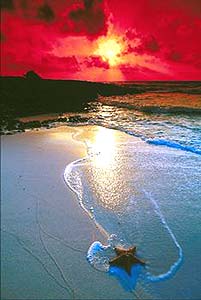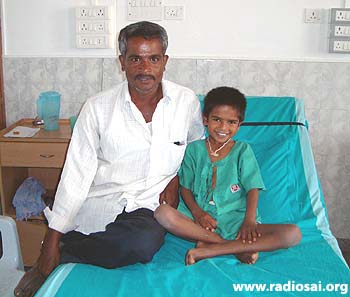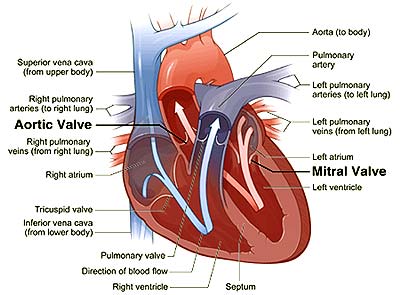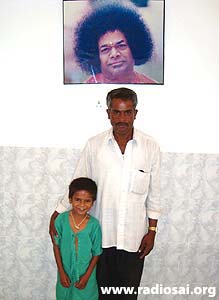 |
 |
 |
Volume
6 - Issue 06
JUNE - 2008 |
A STARFISH AND THE OCEAN Mr. Y. Arvind
“Well, sister how many today?’ I asked at the Nurse’s desk of the CTVS (Cardiac post-operative) ward. “Three”, replied the sister-in-charge, “Mahesh, Ashokan and Anoushika.” I smiled to myself. Turning, I caught the eye of the duty doctor. I wondered if he was having the same thoughts. I was smiling at the thought that generally once in a hospital, a person became a PDA (congenital heart illness), or an ASD (hole in the heart) or a Coronary (clogged arteries), not Mahesh, Ashokan and Anoushika. This is the uniqueness of the SSSIHMS, where we treat the patient, not just the disease. And it was not surprising to see the feeling percolate right down to the front lines. The duty doctor walked up with a smile on his tired face. “Night duty, sir?” I asked, knowing the answer. “Yes, finishing the morning rounds.” He replied, then added, “What’s new, Arvind?” “Just came to find a new starfish, sir!” I replied. “Starfish!?” “Yes…” I gestured to the patients. “Starfish!” “Oh! Starfish!” he exclaimed. “The old man and the little boy on the shores of the ocean? Those starfish?” “Absolutely sir!” Making an Ocean of Difference Whoops! I seem to have got a bit carried away here. In the earnestness of giving you the exact repartee, I lost out on the main stuff. I was referring to the parable of an old man on the shores of a wide ocean. A little boy playing on the beach saw this solitary grey haired veteran walking on the sands close to where the waves ebbed and flowed. Every few steps, the old man would pick up something and throw it back into the sea. The boy ran up and saw to his surprise that the old man was, in fact, throwing starfish back into the sea. His little brown eyes wide open, the boy asked,
“What are you doing, Grandpa?” “What do you think?” replied the old-timer, a twinkle in his blue eyes. “Throwing… starfish… into the… sea?” asked the lad, scratching his head. “Yup!” “But, Grandpa, there are so many,” the boy looked up and down the beach. Hundreds of starfish lay beached on the sands at low tide. He bent down, picked up a small fish and threw it back; then another, and yet another. He stopped and looked up. “Are you going to throw all of them in? The sea will drop them back again tomorrow at low tide. How many can we save?” he continued. “What do you figure? Can we save all of them?” asked the old man sending an orange star splashing into deep blue. “I guess not! Well! Not all of them anyway!” The old man picked up another and sent it flying into the ocean. “But definitely that one! Right!” “Right!” “You see, kid,” he continued straightening his back with a sigh. “It’s not how many we were able to save, but the ones we have saved that matter.” He swept his gnarled palm expansively at the shore line and continued. “I may not be able to make a difference to all of them.” He paused, picked up a starfish, flicked it out to sea and looked into innocent eyes, three score years younger, “But, it definitely makes a difference to that one…” The sun sinking into a fiery red ocean smiled at the two figures throwing starfish into the sea. The reason this story came to my mind was: To a clinician, patients get classified according to the seriousness of the malady. We think, “Yes, that’s a major case; Oh! Yes, that is indeed a major case; that’s a minor case…” But to the patients who are ‘people’ to whom even the thought of surgery is a nightmare, nothing is minor - to a man who knows he is going under a knife, albeit for his own benefit. Often we forget that the ‘minor’ cases too are as much ‘major’ as the ‘major’ ones. These thoughts flashed across my mind as I looked into the mischievous eyes of a young lad grinning up at me with undisguised happiness. A Starfish Worth Saving “Why is he so happy?” I asked a nurse. “He is being discharged today; he is going home!” she replied. “I am going home!” echoed the boy, his eyes dancing with glee. “Mahesh?” I queried arching my eyes at the nurse. “My name is Mahesh!” butted in the lad, “My name is Mahesh!”
I could not but help joining him in the celebration of life. Full of zest for what the future held. The past behind him – he was ‘okay’ now. He was going home…I felt I had to know more about this little starfish. His smile was infectious… I felt, muscles that I had bunched unconsciously, relax. “Who is with him?” I asked the sister. “My father,” piped up the little jack and scampered off only to return a few moments later, leading a short, trim man. The face was lined with many summers, forearms sinewy with hard physical work, the back was straight and well muscled. He walked with firm steps, a man who knew the vagaries of the earth. He smiled uncertainly, apparently unused to attention. “Are you happy that your son is now okay?” I asked cutting to the chase. “Why, of course! I am happy,” he said, the smile growing broader. “Would you like more people to be happy, the same as you? I would like to tell many others about your little boy. Do you have any objection if I do so?” “Why should I have any objection? After all happiness is to be shared.” I turned to the duty doctor. He grinned, patted me on my shoulder, and said, “Onward, my friend, onward!” We sat in a cubicle in the ward, well lit by the sunshine streaming through the huge windows. Mahesh and his father Parshivappa narrated their tale of darkness to light. Mahesh was the second child in a family of three, Nandini being the eldest, and Devamma, the youngest. All the three of them studied in a local government school. ‘5th class’ Mahesh proudly announced. “I am in 5th class, I have finished my exams and will be in 6th class in June.” Smiling indulgently, Parashivappa continued. “We are from the village Attugulipura in the Chamrajnagar district of Karnataka. We have been in the same village for generations. We have four acres of land, and I cultivate coconut and sugar cane. Our area is famous for turmeric and sugarcane,” he added. “Both, coconut and sugarcane, in four acres? Is the land sufficient?” I asked. “The coconut trees are along the boundary,” he clarified. “I make a good living, because the land is fertile. I have a bore well, and we are able to manage in a good manner. We are about three kilometres from two dams, Chikkuvale and Suvarnavati, and about 50 kms away from Najungud, the abode of Lord Nanjundeshwara. Mahesh’s Malady “When did you first identify the problem?” I edged in gently.
“The problem was diagnosed when he was six months old. He was having breathlessness, and kept falling sick often. We took him to our local doctor, and then, we went to Mysore, to paediatricians who suggested some tests. Then after doing the scans as instructed, we went back to our first doctor, Dr. Ramesh. He saw the reports and told us that there is a heart problem. The final diagnosis was that Mahesh had only one cusp in his Aortic Valve as opposed to three that a normal aortic valve should have. He also had a problem with his Mitral valve. And to add insult to injury he had a PDA (congenital heart problem wherein there is abnormal circulation of blood between two of the major arteries near the heart) that was aggravating the other two more serious conditions. In 1998, they approached Jayadeva Hospital, and they were told that a balloon interventional procedure was required. The cost was pegged at Rs.37,000. Since Parashivappa was considered financially stable, he was not granted a green card. In India, the ‘below the poverty line’ populace are given a green card by the Government so that they can avail of medicare at lower prices. The amount was too large to foot, and so Mahesh was put on Penidure injection. “We continued on injections till one day he became very sick. There was blood in his urine. We panicked, and took him immediately to Vikram Hospital in Mysore. We were again told that the operation would cost a lot of money. We, then, went to a Christian mission, and they directed us here.”
“He was having high fever when we came to this Hospital in January 2008. On January 21, an Angiogram was done, and Mahesh was discharged three days later. We were told to come again after three months. We returned to our home town, and were back in the Hospital in April, obtaining an admission date in May. We came again to get Mahesh admitted. Today ( May 15, 2008 ) is the third day after the operation, and the doctors have said it is okay to go home now.” The Infectious Joy of a New Life
I could see that Mahesh was restless, and wanted to say something. “Now that you are okay, what do you want to do?” “I like playing kabbadi, but the doctors say I must take some rest, before I start playing again. I want to be a policeman when I grow up.” “Why?” An impish grin was my reply. Not that it was a whim. The boy had great resilience, and one could see that, beneath the frivolity, was energy that only needed proper direction. “We will come back for a check up if required,” said the father. “I will come back every year for service at Sai Baba’s Ashram for the rest of my life. He has given us so much; we must pass on as much as we can. This place is really a temple.” So ended my morning, and for the rest of the day I wasn’t surprised to have people ask me why I looked so happy. It is only when one touches the waters of a placid lake that the ripples begin. A smile inspires more smiles. A single smile, a dew drop…the laughter of many, an ocean…come to think of it, it all began with the smile of Mahesh. I don’t have to wonder how many starfish will find their place in the sea. I know that the ones that make it back will know how lucky they are. Just as the selfless crusader of the neglected, Mother Teresa so aptly pointed out, “We ourselves feel that what we are doing is just a drop in the ocean. But the ocean would be less because of that missing drop.”
Dear Reader, did this article inspire you in any way? Would you like sharing your feelings with us? Please write to us at h2h@radiosai.org mentioning your name and country. Thank you for your time.
|
|
Vol 6 Issue 06 - JUNE 2008
|
Best viewed in Internet Explorer - 1024 x 768 resolution. |






